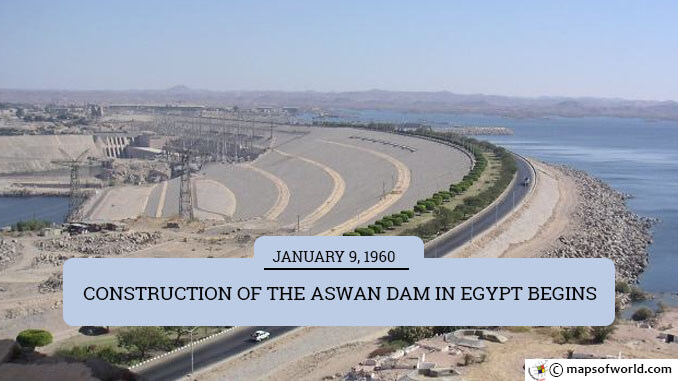The construction of the Aswan High Dam across the River Nile in Egypt began on January 9, 1960, with the removal of about 20 tons of granite by the detonation of dynamite. The dam came to play an important role in curbing the flood and drought cycles of the River Nile that have been a feature of Egyptian life for many centuries. The Aswan High Dam is located on the Nile just about north of the international border between Egypt and Sudan. Prior to the construction of the High Dam, the dam at Aswan was located about 500 miles south of Cairo. While this low dam could provide enough water for irrigation during the drought cycle, it could not control the floods of the mighty Nile. In the 1950s the plan for the High Dam came up under the leadership of the Egyptian President Gamal Abdel Nasser. Having secured a promise of financial assistance from both the US and Great Britain, the new dam promised to be a blessing. The two western nations, however, backed out as a result of an arms agreement signed between the USSR and Egypt. To cover the costs of his ambitious project, Nasser claimed the rights to tolls from the Suez Canal, leading to the Suez Canal crisis. Egypt came under pressure from the UK, France, and Israel. By 1957, when the crisis came to a resolution with US intervention, the Suez Canal was secured by Egypt. The matter of financial aid was solved with the USSR extending loans to cover the project. To proceed with the construction of the Aswan High Dam it became necessary to relocate inhabitants of the Nubian regions of Egypt. About 50,000 Egyptian farmers locally known as the fellahin were relocated to the Kawm Umbū valley at a distance of about 30 miles from Aswan. Thousands of Sudanese nomads were also affected by the construction. They were transported to Khashm al-Qirbah in Sudan. The region that would be inundated by the construction also had to be dug up to look for ancient relics and artifacts. The ancient Egyptian temple complex of Abu Simbel had to be rebuilt at a distance. The temple had originally been built by the pharaoh, Ramses II in the 13th century BC. The temple complex was cut into sections which were then transported individually. A total of 57 million cubic yards of rocks and earth were removed to enable the construction of this dam. After about 11 years of construction, the High Dam across the River Nile at Aswan was completed on July 21, 1970 and officially inaugurated in January 1971. President Gamal Abdel Nasser who had spearheaded the construction of the dam was not able to see the dedication of the dam, though as he had died of a heart attack in September 1970. The construction cost of the dam came to about $1 billion. The dam towers to a height of about 364 feet and has a crest length of 12,562 feet. The volume of water managed by the dam is about 57,940,000 cubic yards. The reservoir at Lake Nasser has a gross capacity of 5.97 trillion cubic feet. About 2.6 trillion cubic feet of water is discharged by the River Nile each year. According to the water-sharing treaty between Egypt and Sudan about 1.96 trillion cubic feet is sent to Egypt and the rest is held back by Sudan. Apart from ending the devastating floods of the Nile, the Aswan High Dam reclaimed more than 100,000 acres of arid desert land for agriculture. Round-the-year irrigation made multiple crops possible in about 800,000 acres of land already under cultivation. Egypt’s economy and many Egyptian villages received a new lease of life with the 12 turbines installed in the dam producing about 10 billion kilowatt-hours of electricity each year. The construction of the Aswan High Dam also produced several negative effects on the environment attracting much criticism. The gradual decline in the fertility of the Nile delta is an alarming effect. The loss of fertility is a direct result of the lack of silt deposited by the Nile each year. Apart from this, the irrigable area created by the dam is plagued by the disease Schistosomiasis spread by snails. Organisms in the Mediterranean Sea have been affected adversely due to the lack of nutrients flowing in from the Nile. You may also like : January 9 1909 – Ernest Shackleton Plants the British Flag 112 miles from the South Pole
January 9 1960 – Construction Of The Aswan Dam in Egypt Begins

